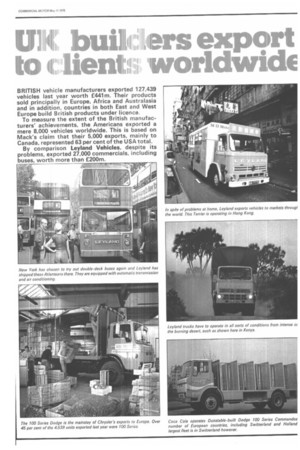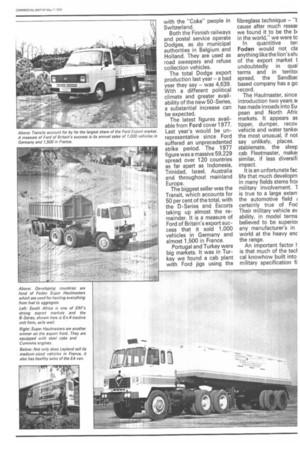UN buikfllH rs export to IL: Herds, worldwide
Page 79

Page 80

Page 81

Page 82

Page 83

If you've noticed an error in this article please click here to report it so we can fix it.
BRITISH vehicle manufacturers exported 127,439 vehicles last year worth £441m. Their products sold principally in Europe, Africa and Australasia and in addition, countries in both East and West Europe build British products under licence.
To measure the extent of the British manufacturers' achievements, the Americans exported a mere 8,000 vehicles worldwide. This is based on Mack's claim that their 5,000 exports, mainly to Canada, represented 63 per cent of the USA total.
By comparison Leyland Vehicles, despite its problems, exported 27,000 commercials, including buses, worth more than £200m.
Leyland is well established in the European market and is fast developing its African interests. It has plants in Kenya and Nigeria where the Boxer and the three ex-Albion stalwarts, the Chieftain, Clydesdale and Reiver are built. The latest addition to its African range is the Range Rover. Across the Atlantic, LV's presence is felt in the USA, where its buses operate in New York.
Chrysler can lay claim to a creditable export record — normally 35 per cent of the output of its Dunstable plant goes abroad. Last year was not so good, when it dropped to 25 per cent. This was due to political problems abroad rather than production problems at home.
The Dodge Commando now underpins the Chrysler export market under the 100-Series banner. Once again its export territory goes well beyond the bounds of Europe. The 100 was used in tipper form in the construction of the Hong Kong railway and has gained a foothold in the tough German market.
Probably Dodge's biggest achievement is the 800 Walk-Thru van fleet of Dutch Railways, built up over 17 years by their oldest distributor Autobedrejf Ten Hoeve of The Hague. They have been in business for 50 years.
Right-hand-drive vehicles are not uncommon in left-hand-drive Europe. They are considered safer for city kerbside deliveries. Coca Cola operates a large fleet of Dodge 100s with Perkins 6.354.3 engines, a model which is also strong with the "Coke" people in Switzerland.
Both the Finnish railways and postal service operate Dodges, as do municipal authorities in Belgium and Holland. They are used as road sweepers and refuse collection vehicles.
The total Dodge export production last year — a bad year they say — was 4,639. With a different political climate and greater availability of the new 50-Series, a substantial increase can be expected.
The latest figures available from Ford cover 1977. Last year's would be unrepresentative since Ford suffered an unprecedented strike period. The 1977 figure was a massive 59,229 spread over 120 countries as far apart as Indonesia, Trinidad, Israel, Australia and throughout mainland Europe.
The biggest seller was the Transit, which accounts for 50 per cent of the total, with the D-Series and Escorts taking up almost the remainder. It is a measure of Ford of Britain's export success that it sold 1,000 vehicles in Germany and almost 1,500 in France.
Portugal and Turkey were big markets. It was in Turkey we found a cab plant with Ford jigs using the fibreglass technique — "k cause after much resear we found it to be the 121, in the world," we were to !n quantitive ten Foden would not cla anything likethe lion's sh of the export market I undoubtedly in qual terms and in territol spread, the Sandbac based company has a go record.
The Haulmaster, since introduction two years al has made inroads into Eu pean and North Afric markets. It appears as tipper, dumper, recov vehicle and water tankei the most unusual, if not say unlikely, places. stablemate, the sleep cab Fleetmaster, make: similar, if less diversifi impact.
It is an unfortunate fac life that much developm in many fields stems froi military involvement. is true to a large exten. the automotive field certainly true of Fod Their military vehicle av ability, in model terms believed to be superioi any manufacturer's in world at the heavy enc the range.
An important factor t is that much of the tea cal knowhow built into military specification fi its way into civilian models. This no doubt contributes greatly to the vehicles' durability in service in the deserts, swamps and quarries of the developing world.
Among all of the British manufacturers, Seddon Atkinson enter an almost negative export story. They claim a "non-brilliant" ex port record which prompts the question, Why ? They have the vehicle, they have the organisation, they have the expertise. In 1979 they exported 400 vehicles. Just over 100 were the SA 400Series and 60 of these were tippers. The other 300 were bus chassis.
Ghana took 300 of the 400 exports, and the balance went to Bermuda, St Lucia, Belize, New Zealand, Somalia, Fiji, Mauri tius, Canary Islands and Greece. Not a big market but undoubted a glamorous one.
Whereas two years ago the export market ac counted for 25 per cent of SA's production, today it is 10 per cent. The company says that rapid expansion of home sales has affected its export effort.
ERF exports 12 per cent of its total production in cluding spares. The big seller last year was the 6x4 tractive unit. Again these Cheshire-built machines carry the flag into unlikely places and only a few years ago had the distinction of pushing a well-known German manufacturer's 120 artic outfits out of Jordan.
In Europe they can be considered moderately strong in overall terms but amongst the leaders in relative terms. The company's Trailblazer slogan applies equally well in the export market, as it does at home.
Bedford is a widely accepted vehicle in Europe. Throughout Scandanavia it has strong support, especially in the kerbside delivery market. The low loading height of the middle-weight models make them ideal for multi-drop loads.
Bedford claims pride of place as Britain's leading exporter. Last year's export production amounted to 59,788 vehicles, its highest ever. They went mainly to Italy, Pakistan, Nigeria, Germany and Portugal.
After the Lord Mayor's Show comes the dustcart, a popular and often derogatory phrase, but not so at Shelvoke and Drewry of Letchworth, where they specialise in refuse collection vehicles for world markets. Among their current customers they claim Middle and Far East, Malaysian, Ghanaian, Nigerian and Kenyan municipal authorities! Their most recent were much nearer home, in Denmark and Holland.
In their Special Purpose Vehicle division, SErD build airfield vehicles with left, right or central drive with a variety of bodies and equipment from Chubb, Carmichael, CFE, Merryweather and Simon. These vehicles find their way to Africa and Asia principally where SErD are strong. lttakes only.a few Mir at the Guildford plar Hestair Dennis to ar ciate that they are ir export business in a way, with buses, lo water tankers, fuel bov% fire tenders, ambulancE most all batches of orders, almost all bour the Far and Middle Ea: Hestair Dennis is ably proud of its n order business. It indi satisfaction first time r if a customer comes especially in an export ket where money is and where the gauge duct durability in the 1 possible conditions.
Domestic customers much of their repeat business on after-sale: vice experience. We many complaints on score, not all of them tied. However, even per cent dissatisfacti too much.
Export customers a different, and from healthy state of the E market, it appears th manufacturers are mc after-sales demands mote locations up to 1 miles away from theta Perhaps the domestic tions of the manufac should look at their e; ing colleagues and their technique, as 1 accounts it's successf




















































































































































































































